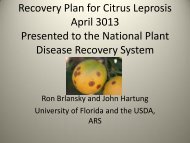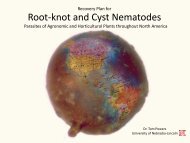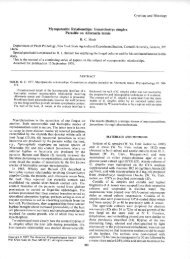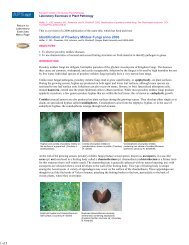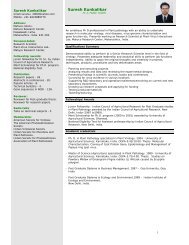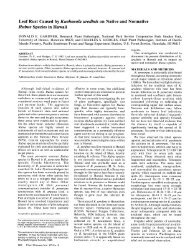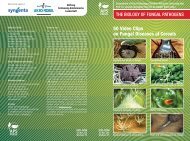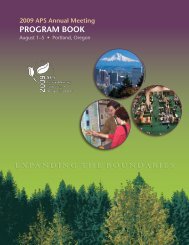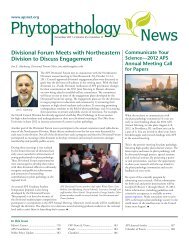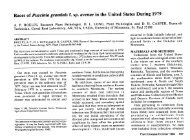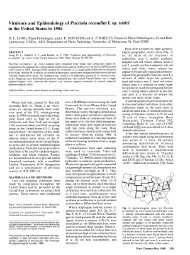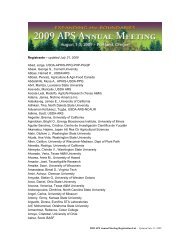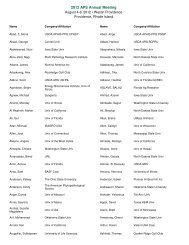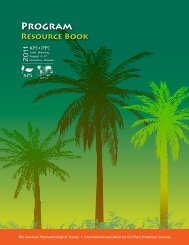view article - American Phytopathological Society
view article - American Phytopathological Society
view article - American Phytopathological Society
You also want an ePaper? Increase the reach of your titles
YUMPU automatically turns print PDFs into web optimized ePapers that Google loves.
were mixed-infected with both CyMV and ORSV; 27.2% were not<br />
infected. The indirect ELISA method was used for virus detection.<br />
118<br />
nase was not associated with immunization in Xanthi-nc<br />
tobacco. Total soluble carbohydrate increased in Kyl4 and<br />
Xanthi-nc immunized with P. tabacina but not in regenerants of<br />
immunized Kyl4 or Kyi4 immunized by TMV.<br />
PHENOL OXIDASES OF FIVE ARMILLARIA BIOSPECIES.<br />
P.M. Wargo, U.S.D.A. Forest Service, Hamden, CT<br />
S.F. Marsh and<br />
06514<br />
122<br />
ASSOCIATION OF PATHOGENESIS-RELATED PROTEINS(PRs), PEROXIDASE<br />
Three isolates each<br />
and<br />
of Armillaria<br />
VII were<br />
biospecies<br />
assayed<br />
groups I,III,V,VI<br />
for constitutive phenol oxidases after 11,<br />
(PER), 0-1,3-GLUCANASE(GL) AND CHITINASE(CH) WITH INDUCED<br />
RESISTANCE OF TOBACCO TO PERONOSPORA TABACINA BUT NOT TO<br />
18,25,32 and 39 days growth in liquid culture. Laccase was<br />
measured in the mycelium, rhizomorphs and extracellular culture<br />
medium. Tyrosinase was only found intracellularly. Averaged<br />
across isolates, intracellular laccase activity was highest at<br />
11 days while tyrosinase and extracellular laccase were highest<br />
at 18 days. Activities of laccase and tyrosinase were not<br />
different among biospecies groups because there were large<br />
differences between isolates within a biospecies group. Among<br />
rhizomo~ph-producing isolates (12), isolates that produced more<br />
rhizomorphs had higher laccase activity. Laccase activity was<br />
also present in isolates that produced no rhizomorphs. Preliminary<br />
results indicate that peroxidase activity may be present<br />
in some isolates. No relation between the enzyme activities<br />
and reported pathogenicity, pH of culture medium, phenol production<br />
or mycelial pigmentation has been found,<br />
SYSTEMIC TOBACCO MOSAIC VIRUS. X. S. Ye S. Q. Pan and J.<br />
Kuc. Dept. of Plant Pathology, University of Kentucky,<br />
Lexington, KY 40546-0091.<br />
Tobacco Ky 14 inoculated with TMV and held at 23C for 3-12<br />
days had localized necrosis on the inoculated leaves and was<br />
systemically protected against blue mold and TMV. Above 28C,<br />
systemic mosaic was apparent. Accumulation of PRs and activi-<br />
ties of PER, GL and CH increased in induced plants. When TMV-<br />
inoculated leaves were removed 12 days after inoculation and<br />
plants were challenged with TMV or P. tabacina and transfered<br />
from 23C to 28C one day after challenge, induced resistance to<br />
P. tabacina but not TMV was apparent. Accumulation of PRs and<br />
activities of PER, GL and CH were further increased after<br />
challenge in induced plants at 23C and 28C. Transfer of plants<br />
from 23C to 28C for 7 days after induction and removal of<br />
inducer leaves did not affect induced resistance to P.<br />
119<br />
tabacina and TMV when challenged and held at 23C for 7 days.<br />
ASSOCIATION OF PEROXIDASE WITH SYSTEMIC RESISTANCE TO<br />
CLADOSPORIUM CUCUMERINUM INDUCED BY COLLETOTRICHUM LAGENARIUM<br />
IN CUCUMBER CULTIVARS RESISTANT OR SUSCEPTIBLE TO C.<br />
CUCUNERINUM. R. Reuveni and J. Ku6. Department of Plant<br />
Pathology, University of Kentucky, Lexington, KY 40546-0091.<br />
123<br />
ENHANCED PEROXIDASE AND ITS PERSISTENCE IN CUCUMBER PLANTS<br />
IMMUNIZED AGAINST ANTHRACNOSE BY FOLIAR INOCULATION WITH<br />
COLLETOTRICHUM LAGENARIUM. R. F. Dalisay and J. Kuc, Dept<br />
Cucumber cultivars susceptible or resistant to C. cucumerinum<br />
were systemically protected by infection of leaf 1 with C.<br />
lagenarium. The protection of leaf 2 was positively correlated<br />
with the concentration of C. lagenarium inoculum, negatively<br />
correlated with the concentration of challenge inoculum<br />
and was not overcome by 106 conidia/ml of C. cucumerinum.<br />
Peroxidase activity increased in protected-leaf 2. After<br />
challenge, peroxidase increased further in protected plants<br />
and was detected as early as 24 hr after challenge in resistant<br />
protected plants. The increase in peroxidase activity<br />
and tandte the apprteaned appearance pants.d and intensification int e icreastion operoxidase of peroxidase ativty isozymes<br />
occurred in the absence of visible damage. Peroxidase after<br />
of Plant Pathology, University of Kentucky, Lexington, KY<br />
40546-0091.<br />
Inoculation of the first true leaf of cucumber plants with<br />
conidia of C. lahenarium induces systemic resistance against<br />
theisa f fr-wkWen temiculate (inde<br />
the same fungus for 4-6 weeks. When the inoculated (inducer<br />
leaf was detached one week after inoculation, resistance was<br />
reduced but persisted for the same time period. Peroxidase<br />
activity was 3-10 x greater in induced plants than in plants<br />
treated with water on leaf 1 and was consistently higher in<br />
plants after leaf with 1 the was inducer induced leaf followed attached. the same Leaves pattern 4-12 for in the protec- bud<br />
to n eoiaeatvt sla .Rslssgetta<br />
challenge may be a useful marker for both induced and non- signal produc e dur ith fs 7aaf te iulation o<br />
induced resistance.<br />
120<br />
signal produced during the first 7 days after inoculation of<br />
leaf 1 affects protection and peroxidase activity of expanded<br />
leaves and leaves in the bud. Once triggered, the response<br />
persists in the absence of the signal.<br />
BIOSYNTHESIS OF SESQUITERPENOID PHYTOALEXINS IN<br />
BACTERIALLY INOCULATED COTTON LEAVES AND COTYLEDONS.<br />
M. Essenberg, H. Hamada, and G. D. Davis. Dept. of Biochemistry,<br />
Oklahoma State University, Oklahoma Agricultural Experiment Siation,<br />
Stillwater, OK 74078-0454.<br />
124<br />
PMG WALL GLUCAN IS AN EFFICIENT ELICITOR OF ISOFLAVONES BUT IS<br />
NOT AN EFFICIENT ELICITOR OF GLYCEOLLIN IN SOYBEANS. T. L.<br />
Graham and M. Y. Graham, Dept. of Plant Pathology, The Ohio<br />
Chemical degradation of 2,7-dihydroxycadalene (DHC) and 2-hydroxy-7methoxycadalene<br />
(HMC) produced in cotton cotyledons from [2-14C,5-<br />
3<br />
H]mevalonolactone following inoculation with an incompatible race of<br />
Xanthomonas campestris pv. malvacearum revealed that biosynthesis of DHC<br />
and<br />
probably<br />
HMC<br />
occurs<br />
involves<br />
as<br />
a<br />
hydrogen<br />
1,3-hydride<br />
transfer to the<br />
shift<br />
isopropyl<br />
during<br />
side chain,<br />
cyclization<br />
which<br />
of the farnesyl<br />
precursor. Gas chromatographic/mass spectrometric analysis of cotyledonary<br />
extracts showed the presence of inoculation-induced substances of molecular<br />
weights 204, 206, 216, 218, and 232, whose mass spectra suggest that they<br />
are intermediates on the pathway to DHC and HMC. High-resolution mass<br />
spectrometry and tH-nmr of the MW 218 compound indicate that it is<br />
C15H22O, 7-hydroxycalamenene.<br />
State University, Columbus, OH 43210.<br />
The cell wall glucans of Phytophthora megasperma f. sp. glycinea<br />
(PMG) elicit glyceollin at nearly hormonal (ng/ml) levels.<br />
However, they are non-race specific elicitors of glyceollin.<br />
Because we have demonstrated that preformed<br />
of<br />
pools<br />
the glyceollin<br />
of conjugates<br />
precursor, daidzein, are used in race<br />
specific accumulation of glyceollin in PMG infected tissues, we<br />
were interested to re-examine the specific role of the glucan<br />
elicitors in relation to these events. We discovered that PMG<br />
glucan is a highly efficient elicitor of daidze in, but is a<br />
very inefficient elicitor of glyceollin. Only 3-20% of the<br />
daidzein in PMG glucan treated tissues is converted to glyceollin,<br />
depending on factors such as light intensity, wounding and<br />
121<br />
tissue age. The results complement earlier studies in<br />
suggesting that effective glyceollin elicitation may require<br />
RELATIONSHIP OF f3-1,3-GLUCANASE AND TOTAL SOLUBLE<br />
either a second elicitor or a specific physiological state of<br />
the tissue perceiving the PMG wall glucan.<br />
CARBOHYDRATE TO THE IMMUNIZATION OF TOBACCO AGAINST BLUE MOLD<br />
CAUSED BY PERONOSPORA TABACINA. S. Q. Pan, x. s. Ye and J. 125<br />
Kuc, Department of Plant Pathology,<br />
Lexington, Ky 40546-0091.<br />
University of Kentucky,<br />
BACTERIAL AND PLANT GENE EXPRESSION IN POTATO SOFT ROT. Z.<br />
Stem injection of Kyl4 tobacco with sporangiospores of P.<br />
acina or leaf inoculation with tobacco mosaic virus (TMV)<br />
tab-<br />
Yfang, C.L. Cramer, and G.M.<br />
Biology of Plant Stress, VPI&SU,<br />
Lacy, Laboratory for Molecular<br />
Blacksburg, VA 24061-0330.<br />
systemically immunized plants against disease caused by both<br />
pathogens and systemically increased -1,3-glucanase activity.<br />
After challenge with P. tabacina, lI-1,3-glucanase also increased<br />
earlier and more rapidly in immunized plants and their<br />
tissue culture regenerants than in controls. One dominant<br />
intercellular isozyme of P-l,3-glucanase was associated with<br />
immunization before and after challenge and another with symptom<br />
expression after challenge only in controls. P-1,3-gluca-<br />
A membrane-separated system involving potato tuber slices and<br />
Erwinia carotovora subsp, carotovora (Ecc) was used to study<br />
simultaneous in planta regulation of bacterial pathogenicity-<br />
related and defense-related genes in soft-rot interaction.<br />
Northern hybridization showed increases in pathogenicity-<br />
related genes including endo- and exo-pectate lyases (PLs) and<br />
endo-polygalacturonase (PG) within 3 hr reaching maxima beteen<br />
6 and 12 hr. Most defense responses were monitored by phenylal-<br />
1150 PHYTOPATHOLOGY



